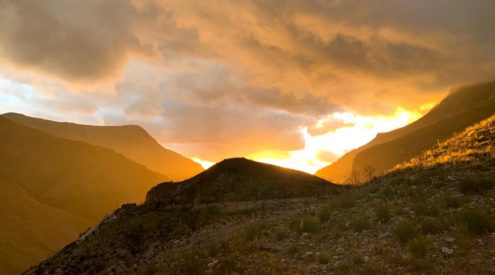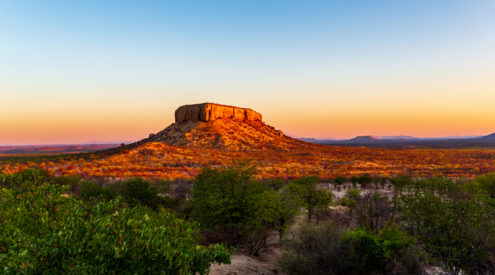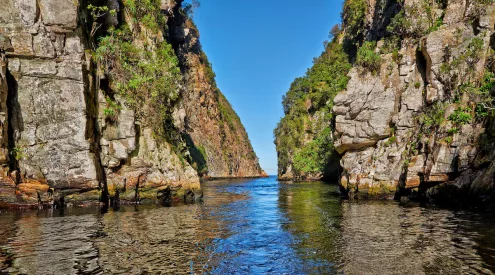In typical crispness, Ernest Hemingway once wrote, “Kilimanjaro is a snow-covered mountain 19,710 feet high, and is said to be the highest mountain in Africa. Its western summit is called by the Masai ‘Ngà je Ngà i,’ the House of God. Close to the western summit there is the dried and frozen carcass of a leopard. No one has explained what the leopard was seeking at that altitude.”
High on the literary fuel of a dozen authors, I realise that it’s 2am on a Sunday morning and the anxiety has hit me. Like a Dear John letter from a jaded lover, this feeling has been in the post for a while, but it’s only now that it’s breached the sanctuary of my bedroom. But I’d be lying if I were to defend my restlessness with tales of late-night debauchery and discotheque athleticism. Those nights leave patches of memory notable only for their brevity. In any case, I’m more prone to falling over my own boots than elegantly squeaking tekkie on the dance floor. My team will bear testament to this, knowing that my propensity for tempting acrophobia is reason enough for them to exercise extra precaution around me. The simple, boring truth is that I was awoken by the characteristic wetness of a middle ear infection. What has kept me awake, however, is the prospect that in 35 days time, I will either be lying in a small room in Moshi, Tanzania, with a smile on my face and the weight of accomplishment on my shoulders, or a lingering acceptance that Kili had defeated me.
In an attempt to establish some rigidity in an otherwise erratic lifestyle, I’ve been clipping the wings of indulgence that Cape Town’s night-life demands. Early nights and early mornings, I keep telling myself, because a little sacrifice goes a long way. But, as with most men of similar disposition, I was born with a scruffy haircut and a penchant for procrastination. The illusion of self-discipline that I call my exercise routine has given me bursts of confidence in the months preceding our climb, but it’s the elements that are out of my control that leave a question mark on the finality of the expedition, and along with that – my peace of mind. I guess that’s why the prospect of altitude sickness and sub-zero temperatures scares – and excites – me the most. After several tough hikes, most notable of which was a trek up Sneeuberg Peak after a 3 hour sleep, a 4 hour drive and a 12 hour ordeal – five hikers, most of whom resembling the Russian Mafia found themselves a bit too far off the beaten track, lost in the Cederberg at 10pm – I can bravely, though naively, say that I am ready.
Now I’ve been thinking a lot about what my first blog post should be about, and have even consulted a friend whose ability to tell a story possesses a quality recognisable only by the faintest recollection of a time when I was young. You know the kind of story I’m talking about. The kind that would be told by the sage old grandpa rocking himself into oblivion, perched by the fireplace in the corner of the room, a ring of children around him and the taste of adventure on his lips. He’d know what to say. He’d know what to write. And his voice would probably sound like Morgan Freeman’s. But it’s a little tricky to tell a story when you’re yet to lace your boots. All I know is that the stories and photographs will come afterwards, because sitting in the relative warmth of a Rondebosch bedroom does little for one’s preparation other than stoking the flames of doubt that cluster around the personal anecdotes of others. For the time being, any knowledge I impart on Kilimanjaro is entirely theoretical, which, admittedly, paints a target on my back knowing that someone reading this blog has already done Kili, and no doubt finds my pre-climb jitters amusing.
To say that climbing Kilimanjaro (or “˜Kili’, as those of us naive enough to mollycoddle its name) has been a dream of mine is a brutal understatement. Everyone should have a bucket list, and Kili has been scribbled all over the plastic shell of mine since I was a child. And maybe that’s the problem. I have a distinctive memory of James May of Top Gear acclaim sitting behind the wheel of the Lamborghini Countach, sullen and subdued as a lifetime of expectation tainted his experience of the iconic supercar. His words were as priceless as the leather seats he sat upon. “I’m absolutely gutted”, he said, “But you know what, it’s not the car’s fault, it’s mine. I’ve broken a golden rule: You never, ever meet your childhood heroes”.
And that brings me back to the point. What can I expect from Kili? I’ve been told that every step on summit night is despairingly slow to the extent that despondency and depression will settle on my shoulders like two devils picking a fight with that tiny kernel of perseverance that says, “˜You can do it’. I’ve been told that young males struggle the most with altitude sickness due to their penchant for exertion when caution is most needed. I’ve even read that oxygen-starved smokers are remarkably resilient at coping with the effects of altitude sickness. And most worryingly of all, I’ve been told that the sounds of retching, crying and snotty noses will accompany me for a good portion of the journey – especially on summit night. As I sit here, a thousand thoughts ricocheting around my cerebral cortex, it seems impossible to align my expectations with the reality of the climb. And that worries me. Have I put Kili on a pedestal so high that it can only fall into the abyss of disappointment? Like the poster-laden bedroom of the young James May, my bucket list may have cultivated a set of expectations a trifle too boyish to handle the clunky power of the Countach. Or should I say, the troublesome slog of the Machame Route.
At 5895 metres, Kili is above the average altitude at which high altitude pulmonary edema (HAPE) or high altitude cerebral edema (HACE) occur. Shortage of breath, hypothermia and a constant headache will inevitably be part and parcel of the deal. Yet, as the fourth highest mountain of the Seven Summits, the highest mountain in Africa, and the tallest free-standing mountain in the world, Kili cuts a lonely figure in mountain lore, being the victim of frequent tourist traps and commercialisation that sees its solitude reduced almost as quickly as its glaciers. In that way, Kili is a little like King Kong, thrust out of the wilderness and into the limelight, dragged into the mainstream and plastered all over the dreams of anyone with a dusty pair of boots, a Kodak camera and a vague inclination to attempt the Coca-Cola Route (which, as its name suggests, serves Coca-Cola along the way). And, like any other tourist, I am about to commodify this beast of the ancient world with the heavy footfalls of my boots and the frequent snap of a digital camera. I’ll probably even buy a handful of generic curios to remind me of my first taste of east Africa. From a foreigner’s perspective, these gifts are part of the experience. For the people making them, I’m just a walking wallet. No one asked Kili if we could do this to her. We just drive some pickaxes into her skin, take some poorly composed photographs and assume that she will allow us safe passage. Yet, the fact that an uncomfortably low 50-60% of people reach the summit of Uhuru Peak leaves a subtle sense of urgency bubbling under my expectations. This isn’t a beast that we conquer by might alone. This is a beast that will let us rest upon her crown with her permission only.
Kili is changing, estimated to be glacier-less by the year 2030, leaving it a little scared, ready to subdue the superciliousness of its trekkers with bouts of icy wind and hypothermia should it feel its generosity has been exploited. Yet in some strange way, has its cruelty made it more approachable, for those who respect its intensity? Kilimanjaro’s saving grace (at least, for the average hiker) is that it is fundamentally doable. Which is why someone like myself, who is as cumbersome as Mr Bean on a pair of rollerblades, is attempting it. Kili is my childhood hero, and with a little persuasion and pacing, my expectations will hopefully match the reality of the climb. I can only hope that when the guides wake us at 11pm for the final ascent up Kibo’s crater rim, the wild cat would have loosened her claws, allowing me safe passage and relative comfort as we look upon the curvature of the earth with wry smiles and chilly faces. Or else, I may just become Hemingway’s leopard, lying on the snowy slopes of the western summit, a story to tell but no one to listen.
Welcome to my blog. It promises to be as naive and callow as one would expect from someone who is yet to embark on this little journey up north. And thank you Getaway for letting me be a piece of furniture in this digital lounge. I’m psyched.

















